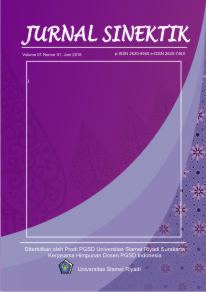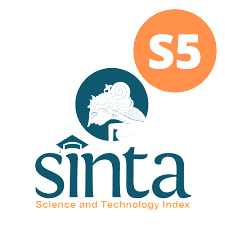PENGGUNAAN PENDEKATAN KONTEKSTUAL DALAM MENINGKATKAN KARAKTER PEDULI LINGKUNGAN SISWA KELAS 3
DOI:
https://doi.org/10.33061/js.v6i2.8190Keywords:
contextual, environment, characterAbstract
This study aims to describe the implementation of Environmental Education learning at the elementary school level, as well as to determine whether there is an increase in students' environmental awareness through Environmental Education with a Contextual Learning Approach, in which this approach links between the content of subject matter and real-life situations from oneself. students to build relationships between the knowledge they have and their daily lives. This research is a qualitative research with a type of field study and literature study. And using Classroom Action Research which is designed in one cycle consisting of 4 stages. Data collection techniques used are interviews, observation and documentation. The results of the research show that the learning of Environmental Education at SDN 2 Sindangkasih is implemented quite well. As for its implementation, Environmental Education takes an important role that influences the character of students.
References
Afandi, Rifki. (2013). Integrasi Pendidikan Lingkungan Hidup Melalui Pembelajaran IPS Di Sekolah Dasar Sebagai Alternatif Menciptakan Sekolah Hijau. Jurnal Pedagogia, 2(1), p. 98-108.
Aripin, I. (2017). PEMBELAJARAN PENDIDIKAN LINGKUNGAN HIDUP BERORIENTASI 3R (REUSE, REDUCE AND RECYCLE) UNTUK MENINGKATKAN KREATIVITAS DAN SIKAP PEDULI LINGKUNGAN. Jurnal Bio Educatio, Volume 2, Nomor 2. p. 01-11
Bloom, Benyamin S. (1956.) Taxonomy of Educational Objective: Book I Cognitive
Candrawati, T. (2021). Pemahaman Guru PAUD tentang Literasi Lingkungan Terkait dengan Pendidikan Lingkungan Hidup. Seminar Nasional PAUD Holistik Intergratif. Magister Pendidikan Nonformal Pascasarjana Universitas Negeri Gorontalo
Domain. N.Y.: Longman Inc.
Good, T.L. & Brophy, J.E. (1990). Educational Psychology. New York: Longman
Handoyo, B. (2002). Model Sekolah Hijau Berbasis Sekolah Setempat di Sekolah Dasar Sekitar Sungai Bango Sawojajar Malang. Laporan penelitian tidak diterbitkan. Malang: Lemlit Universitas Negeri Malang.
Kementrian Sumber Asli dan Alam Sekitar. (2004). Anugerah Sekolah Rakan Alam Sekitar (SERASI), Minggu Alam Sekitar Malaysia/ MASM. Kinibalu: Unit Pendidikan dan Sebaran Maklumat
Kunandar. (2007). Guru Profesional Implementasi Kurikulum Tingkat Satuan Pendidikan (KTSP) dan Sukses Sertifikasi Guru. Jakarta: Rajagrafindo Persada
Neal, L. H. O. (1995). Using Wetlands to Teach Ecology and Environmental Awareness in General Biology. The American Biology Teacher. New York: The National Association of Biology Teachers Vol 57 No 3.
North American Association for Environmental Education. (2001). Using Environment-Based Education to Advance Learning Skills and Character Development. A Report, Annotated Bibliography, and Research. Washington: NEE & Training Foundation.
Pembangunan. Jakarta: Universitas Indonesia Press,
Piaget, Jean, dan Barbel Inhelder, (1969). The P sychology of Child , London: Routledge & Kegan Paul
Soerjani. (1992). Lingkungan, Sumber Daya Alam dan Kependudukan dalam
Supranoto, Heri. (2016). PENGARUH CONTEXTUAL TEACHING AND LEARNING (CTL) TEKNIK PRAKTEK JUAL BELI TERHADAP KEMAMPUAN MAHASISWA MEMAHAMI AKUNTANSI PROGRAM STUDI PENDIDIKAN EKONOMI UM METRO. JURNAL PROMOSI: Jurnal Pendidikan Ekonomi UM Metro. Vol.4. No.2 .p.36-42
Utina, R & Baderan, D.W.K. (2009). Ekologi dan Lingkungan Hidup. Gorontalo: Universitas Negeri Gorontalo Press
Downloads
Published
How to Cite
Issue
Section
License
Copyright (c) 2022 Jurnal Sinektik

This work is licensed under a Creative Commons Attribution-NonCommercial 4.0 International License.
Authors who publish this journal agree to the following terms:
- Authors retain copyright and grant the journal right of first publication with the work simultaneously licensed under a Creative Commons Attribution License that allows others to share the work with an acknowledgement of the work's authorship and initial publication in this journal.
- Authors can separately make additional contractual arrangements for non-exclusive distribution published by the journal (e.g., publish it in a book), with an acknowledgement of its initial publication in this journal.
- Authors are allowed and encouraged to send their work via online (e.g., in the institutional repositories or their website) after published by the journal.














